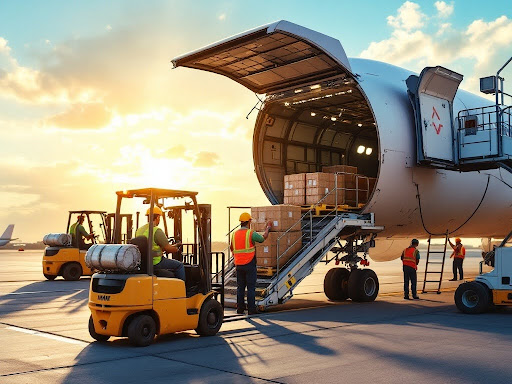
For businesses that rely on fast and efficient shipping, air freight is one of the most reliable ways to transport goods across long distances. Whether you need to move time-sensitive products, high-value shipments, or perishable goods, air freight provides a solution that minimizes delays and ensures secure delivery. Understanding how it works can help businesses optimize their logistics, reduce costs, and improve overall supply chain efficiency.
This guide covers everything business owners need to know about air freight, from its step-by-step process to cost factors and best practices. With the right approach, businesses can take full advantage of air freight to expand their reach and enhance their operations.
What Is Air Freight?
Air freight, also known as air cargo, refers to the transportation of goods via aircraft. Unlike other forms of shipping such as ocean freight or ground transport, air freight prioritizes speed, allowing businesses to move products rapidly across the globe. It is particularly useful for high-value, time-sensitive, or perishable goods that require urgent delivery.
Air freight can be categorized into two main types:
- Commercial Air Freight – This type of cargo is transported on passenger planes alongside luggage and mail. Airlines allocate specific sections of the aircraft for cargo, making it a cost-effective option for businesses that need to ship smaller loads.
- Dedicated Cargo Freight – These shipments are transported on cargo-only planes operated by airlines specializing in logistics, such as FedEx, DHL, and UPS. This option is ideal for businesses that need to move larger shipments or special cargo that requires unique handling, such as pharmaceuticals, automotive parts, or high-tech electronics.
Twings Supply, a trusted name in international freight forwarding, helps businesses navigate the complexities of air freight by offering customized solutions for various shipping needs. Their expertise ensures smooth transportation, from booking to final delivery, reducing risks and improving efficiency.
How Air Freight Works Step by Step

Shipping goods via air freight involves several crucial steps. Here’s a breakdown of how the process works:
Booking the Shipment
The business contacts a freight forwarder or an airline cargo service to arrange the shipment. Freight forwarders help secure space on flights, negotiate costs, and coordinate logistics, ensuring a seamless shipping process.
Packaging and Labeling
Proper packaging is essential to ensure that goods are protected during transit. Businesses must use durable packaging materials, secure fragile items, and comply with airline regulations. Labels must include essential details such as the consignee’s information, handling instructions, and barcodes for tracking.
Customs Documentation
Export documents such as invoices, packing lists, and airway bills are prepared to comply with international trade regulations. Accurate documentation prevents delays and ensures smooth customs clearance.
Pickup and Transport to Airport
The goods are collected from the sender’s location and transported to the airport using trucks or vans. This step requires careful coordination to align with flight schedules and avoid delays.
Security Screening and Customs Clearance
Goods undergo rigorous security checks to prevent prohibited items from being transported. Customs officials inspect documents and cargo to ensure compliance with import/export laws before allowing the shipment to proceed.
Air Transport to Destination Airport
The cargo is loaded onto the aircraft and transported to the designated airport. Depending on the distance, the shipment may include layovers or transfers at intermediary airports.
Customs Clearance at Destination
Upon arrival, the shipment must clear customs before final delivery. Customs officers review the paperwork, assess duties and taxes, and ensure compliance with local regulations. Delays at this stage often occur due to incomplete or incorrect documentation.
Final Delivery to Recipient
After customs clearance, the goods are handed over to a local carrier for final delivery to the buyer’s location. Businesses often use real-time tracking to monitor the shipment’s progress and ensure timely arrival.
Advantages of Using Air Freight for Businesses
Businesses choose air freight for several reasons. Here are some key benefits:
- Speed and Efficiency – Air freight is the fastest mode of international shipping, making it ideal for urgent deliveries.
- Global Reach – Businesses can ship goods to almost any location worldwide.
- Reliable Scheduling – Airlines operate on fixed schedules, reducing the risk of delays.
- Secure Transportation – Strict security measures minimize the risk of theft or damage.
- Reduced Inventory Costs – Faster delivery times allow businesses to maintain lower inventory levels.
Key Factors Affecting Air Freight Costs
Air freight costs can vary based on several factors:
- Weight and Volume – Airlines charge based on actual weight or volumetric weight, whichever is higher.
- Distance and Destination – The farther the destination, the higher the cost.
- Customs Duties and Taxes – Import duties and taxes can affect the overall cost of shipping.
- Fuel Surcharges – Fluctuations in fuel prices can impact air freight rates.
- Additional Services – Insurance, special handling, and expedited delivery may add to the cost.
Essential Documents Required for Air Freight
Shipping goods via air requires several important documents, including:
- Airway Bill (AWB) – A contract between the shipper and the airline.
- Commercial Invoice – Provides details about the goods being shipped.
- Packing List – Describes the contents of the shipment.
- Certificate of Origin – Confirms the country where the goods were manufactured.
- Customs Declaration – Required for clearing goods at customs.
Best Practices for Businesses Using Air Freight
To maximize the benefits of air freight, businesses should follow these best practices:
- Choose a Reliable Freight Forwarder – Work with an experienced provider to handle logistics.
- Optimize Packaging – Use durable and lightweight packaging to minimize costs.
- Plan for Customs Clearance – Ensure all required documents are in order to avoid delays.
- Track Shipments in Real Time – Use tracking services to monitor your cargo.
- Evaluate Cost vs. Speed – Consider whether air freight is the most cost-effective option for your needs.
Common Challenges and How to Overcome Them
High Shipping Costs
Air freight is more expensive than other shipping options, but businesses can reduce costs by consolidating shipments, negotiating bulk pricing with freight forwarders, and optimizing packaging to reduce dimensional weight. Selecting less time-sensitive shipping options can also lower expenses.
Customs Delays
Incomplete or incorrect documentation is one of the leading causes of customs delays. Businesses should ensure that all paperwork is accurate and up to date. Partnering with an experienced customs broker can help expedite the clearance process and avoid unnecessary holdups.
Limited Cargo Space During Peak Seasons
During peak seasons, such as holidays or major global events, cargo space becomes limited, leading to higher prices and potential delays. Businesses should book shipments well in advance to secure space and consider alternative shipping routes or carriers when necessary.
Industries That Benefit Most from Air Freight
Some industries rely heavily on air freight due to its speed and reliability:
- E-commerce and Retail – Faster deliveries improve customer satisfaction.
- Pharmaceuticals – Timely delivery of medical supplies and vaccines is critical.
- Automotive – Rapid shipment of spare parts reduces downtime.
- Technology – Ensures the timely arrival of high-value electronics.
- Perishable Goods – Fresh food and flowers require fast transportation.
Steps to Choose the Right Air Freight Partner
- Assess Your Shipping Needs – Determine the volume and frequency of shipments.
- Compare Freight Forwarders – Look for experience, pricing, and customer service.
- Check Carrier Network – Ensure they serve the routes your business requires.
- Review Security and Compliance Standards – Choose a partner that meets industry regulations.
- Negotiate Rates and Services – Work out a deal that suits your budget and shipping timeline.
Final Thoughts
Air freight is a valuable shipping solution for businesses that need speed, security, and global accessibility. While it may come with higher costs than other transportation methods, its efficiency often outweighs the expense, especially for businesses that prioritize timely delivery.
By carefully managing logistics, working with experienced freight partners, and staying informed about industry best practices, businesses can maximize the benefits of air freight. A well-planned air freight strategy not only improves shipping efficiency but also helps companies stay competitive in today’s fast-paced market.











1 thought on “How Air Freight Works and What Business Owners Need to Know ”